Panthera onca
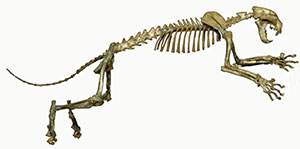
Quick Facts
Common Name: jaguar
Fossils of jaguars in Florida are much more common than those of other contemporaneous large felids, such as the American lion and the sabertooths Smilodon fatalis and Dinobastis serus.
The Pleistocene jaguars of North America were much larger than those living today in Central and South America, and for that reason are sometimes placed in the extinct subspecies Panthera onca augusta.
Jaguars evolved in the Old World and first dispersed to North America across the Bering Land Bridge in the Pleistocene.
Age Range
- Middle Pleistocene Epoch to Recent; late Irvingtonian to Rancholabrean land mammal ages
- About 500,000 years ago to present
Scientific Name and Classification
Panthera onca Linnaeus, 1758
Source of Species Name: The species name comes from the Portuguese word for jaguar, onca. This word is thought to be derived from the Greek word for a lynx, lunx.
Classification: Mammalia, Eutheria, Laurasiatheria, Carnivora, Feliformia, Aeluroidea, Felidae, Pantherinae
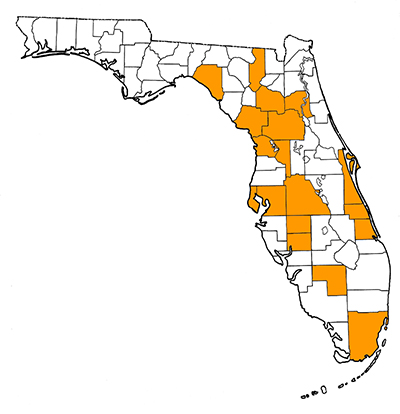
Alternate Scientific Names: Felis onca; Felis augustus; Felis veronis; Panthera onca augusta (does not include eight additional species names based on modern specimens; for these see Seymour, 1989)
Overall Geographic Range
Historically, the species ranged widely from the southwestern United States to northern Argentina, but it is now extinct or nearly so in much of that area, including the United States and most of Mexico. During the Pleistocene the jaguar ranged much further to the north and east, with records from Nebraska, Washington, and Maryland. Its greatest known fossil concentrations are in Florida and eastern Tennessee. The type locality is near Pernambuco, Brazil (Seymour, 1989).
Florida Fossil Occurrences
Florida fossil sites with Panthera onca:
Discussion
All true cats, extant and extinct, are classified in the mammalian family Felidae. Panthera onca, commonly known as the jaguar, is an extant member of the felid subfamily Pantherinae, which is composed of the generaNeofelis (clouded leopard) and Panthera, which are represented by a number of extant and extinct forms. Other extant members of Panthera include Panthera leo (lion), Panthera pardus (leopard), Panthera tigris (tiger), and Panthera uncia (snow leopard). The subfamily Pantherinae is thought to have diverged from all other living cats about 16 million years ago (Zheng et al., 2014), making this lineage the oldest among the extant members of the family Felidae.
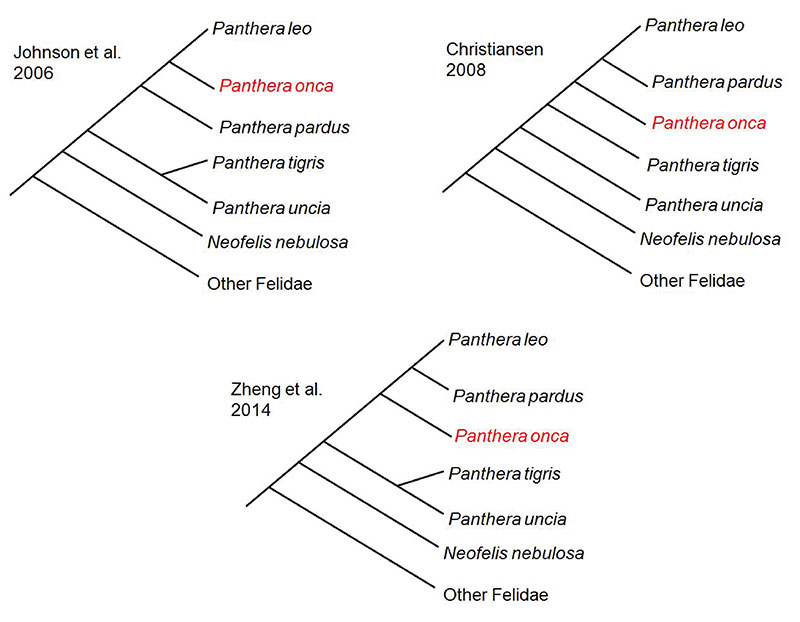
The evolutionary relationship of Panthera onca relative to other pantherines was under some debate, as different phylogenetic analyses have yielded mixed results (Figure 2). One phylogenetic analysis based on molecular (DNA) evidence suggested that the jaguar and lion are most closely related to each other and comprise a monophyletic group that is most closely related to the leopard (Johnson et al., 2006). A morphological (anatomical) and ethological (behavioral) phylogenetic analysis suggested that the lion and leopard are actually most closely related to each other and are a monophyletic group most closely related to the jaguar (Christiansen, 2008). Most recently, a combined morphological/ethological/molecular analysis concluded that the jaguar is likely most closely related to the group that comprises of the lion and leopard at the exclusion of other pantherines (Zheng et al., 2014). It is thought that the group comprising Panthera onca, Panthera pardus, and Panthera leo diverged from other pantherines about 8 million years ago (Zheng et al., 2014)
While Panthera onca is alive today, this species has a rich fossil record. It is thought that the jaguar evolved in Eurasia and crossed the Bering Land Bridge in the early Pleistocene, and was initially a part of a species distributed widely across the Old and New Worlds (Kurtén and Anderson, 1980). The oldest fossil jaguars in North America have been found in the middle to late Irvingtonian (middle Pleistocene epoch) of California, and they first appear in the fossil record of South America in the late middle or early late Pleistocene (Hemmer, 2010). Thus, modern jaguars in South America are the only surviving remnant population from a wider past distribution (Kurtén, 1973; Kurtén and Anderson, 1980, Hemmer, 2010).
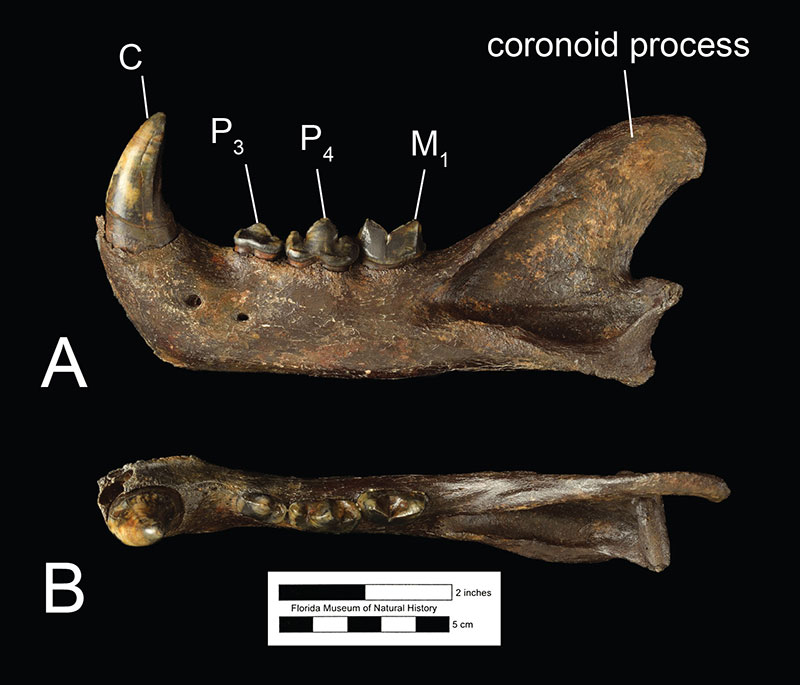
Modern members of this species are about 1.12 to 1.85 m (or 3.7 ft to 6 ft) in head to tail length and weigh about 36 to 158 kg (or 80 to 348 lbs). They are the third largest cat today after the lion and the tiger (Seymour, 1989). In the Pleistocene Epoch, however, Panthera onca was between 15 to 20% larger in size compared to the modern form (Kurtén and Anderson, 1980). In particular, the legs were about 6% longer and the forefeet and hindfeet were about 9.5% longer in the fossil form relative to the extant form. The teeth of the modern jaguar are also reduced in length compared to the fossil form (Kurtén, 1973). This may be due to an evolutionary trend towards smaller size in the modern forms or due to the effect of latitude. It has been noted that in modern jaguars, populations with the smallest body sizes habitate in the equatorial regions while individuals from populations to the north and south of the equator are larger (Simpson 1941; Kurtén, 1965). The fossil jaguars in North America would have been present farther north than the extant distribution, which could explain their larger size.
While a variety of behavioral, genetic, and soft-tissue differences help distinguish Panthera onca from other closely related pantherines (see Seymour, 1989 for a diagnosis and the Animal Diversity Web for more information on the extant species), they may also be distinguished using a number of osteological characters. Dentally, Panthera onca is characterized by an adult dental formula of 3 incisors, 1 canine, 3 upper and 2 lower premolars, and 1 molar (3/3 : 1/1 : 3/2 : 1/1). Relative to other extant pantherines, the lower canines are larger, the lower third premolar is smaller and the lower first molar is shorter (Figure 3). The skull is characterized by a wide snout (rostrum) and cheek bones (zygomatics), and there is a prominent sagittal crest (Seymour, 1989).
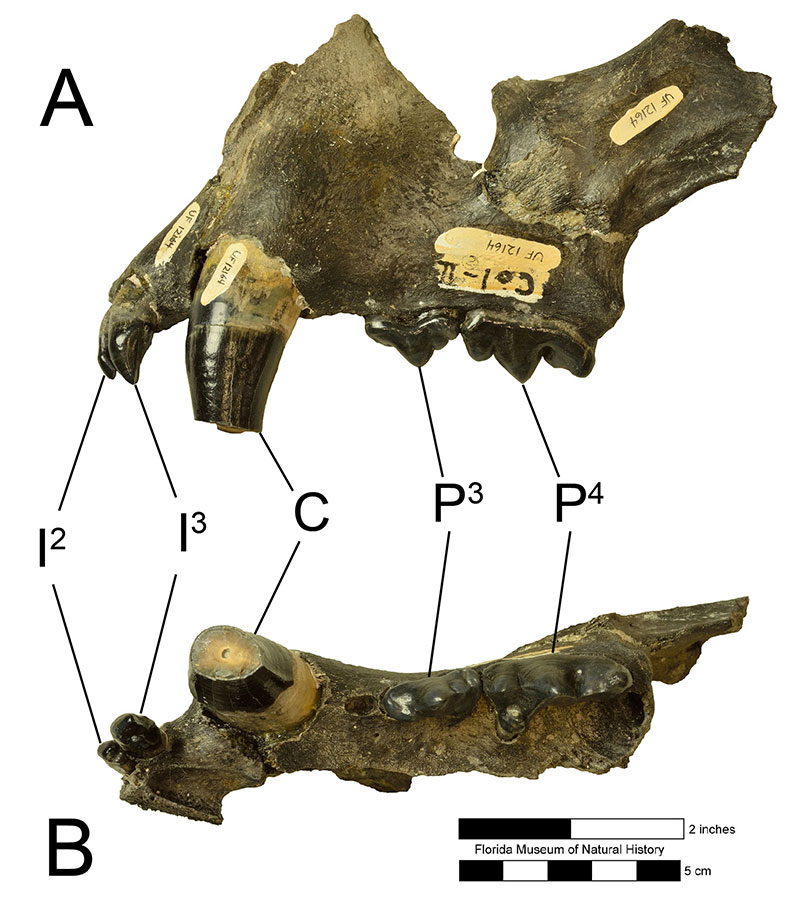
Fossil forms of Panthera onca may also be differentiated from other fossil felids, although this task is complicated by a scarceness of specific osteological characters that differentiate co-occurring large fossil felids in North America (Morgan and Seymour, 1997). Panthera onca is primarily differentiated from Panthera atrox, the extinct American lion, by the fossil jaguar’s smaller size. However, while Panthera onca existed in the same time periods as Panthera atrox, they rarely occur in the same localities. Panthera onca is present in the Irvingtonian North American Land Mammal Age (NALMA) of California but is absent from the younger Rancholabrean NALMA of California, when Panthera atrox is common. Likewise, while Panthera onca is common in the fossil record of Florida, Texas, and Tenessee during the Irvingtonian and Rancholabrean, Panthera atrox is rare or not present (Kurtén and Anderson, 1980). This apparent lack of concurrent occurrences may be due to competition and/or differences in preferred habitats between the two species. Based on the behavior of the modern form and the similarity in anatomy of the fossil form to that of the modern jaguar, the fossil jaguar is also thought to have preferred forested habitats. On the other hand, the association of Panthera atrox with plains-adapted animals at Rancho la Brea and this species’ more slender, longer-limbed anatomy suggests that Panthera atrox was a more cursorial animal adapted to life in more open habitats (Kurtén 1965). Thus, it may be that Panthera onca and Panthera atrox are not found together because they did not live in the same environments.
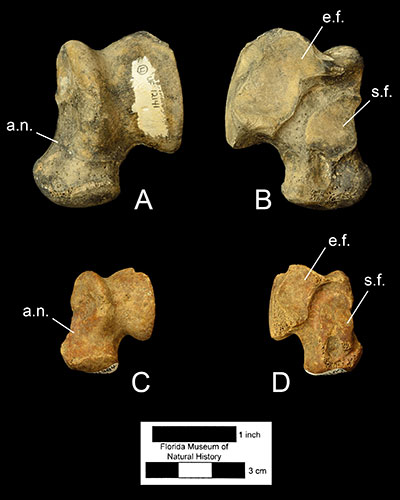
The fossil jaguar differs from the sabertooth cat, Smilodon, in several ways as well. Most obviously, P. onca does not possess the large saber-like upper canines of Smilodon (Figure 4). The canines of the jaguar are rounder and more conical in shape. The coronoid process of the mandible (Figure 3A) is also taller in the jaguar than Smilodon, and the deciduous carnassial teeth of Smilodon and Panthera onca have been compared in some detail, and have been found to be diagnostically different (Kurtén, 1965).
Fossils of Panthera onca may be differentiated from fossil pumas (Puma concolor) based on characters of their ankle bones. The ectal facet, or one of the contact surfaces between the astragalus and calcaneus on the astragalus, is narrower and posteriorly pinched in the puma (Figure 5). In addition, the sustentacular facet, the other surface of contact between the astragalus and calcaneus on the astragalus, is more posteriorly drawn than the puma. The astragalar neck is also relatively shorter in Panthera onca compared to Puma. While difficult to observe from Figure 5, pumas also generally have larger feet than jaguars of similar size (Kurtén, 1965).
Sources
- Original Authors: Richard C. Hulbert, Jr. and Arianna R. Harrington
- Original Completion Date: March 20, 2015
- Editors’ Names: Richard C. Hulbert, Jr., Natali Valdes, and Arianna R. Harrington
- Last Updated On: April 9, 2015
This material is based upon work supported by the National Science Foundation under Grant Number CSBR 1203222, Jonathan Bloch, Principal Investigator. Any opinions, findings, and conclusions or recommendations expressed in this material are those of the author(s) and do not necessarily reflect the views of the National Science Foundation.
Copyright © Florida Museum of Natural History, University of Florida